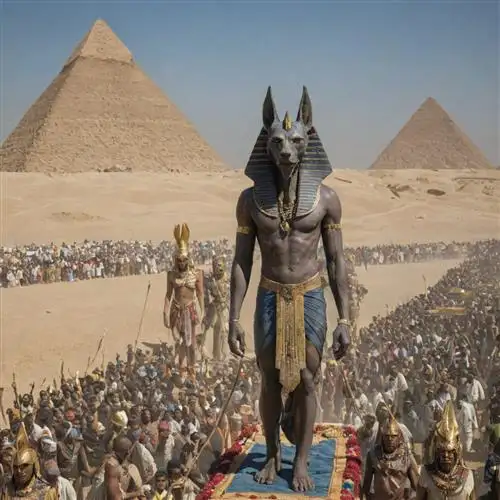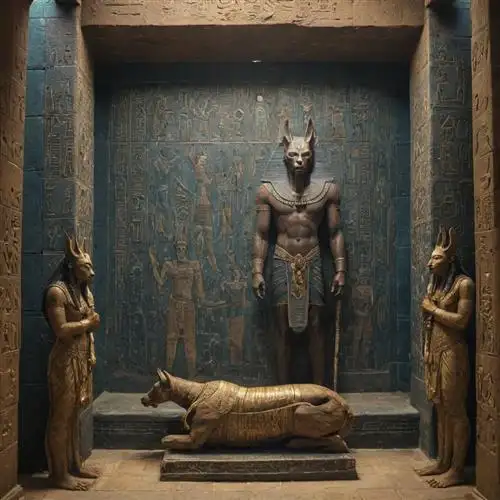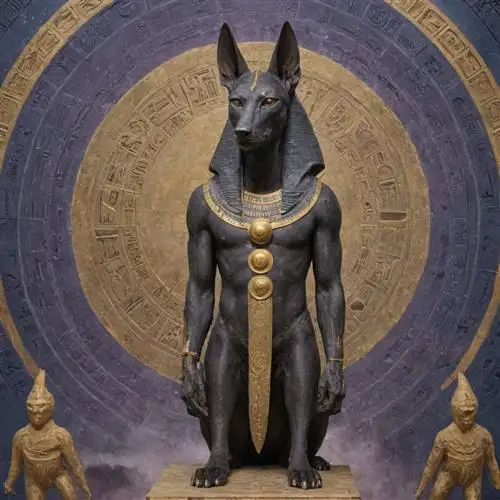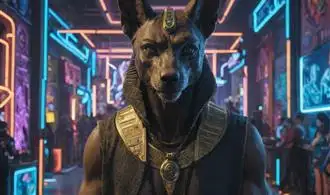
Anubis The God of Embalming and Funerals
Anubis, the ancient Egyptian god of embalming and funerals, holds a profound and intriguing place within the pantheon of Egyptian deities. As the guardian of the dead, Anubis played a crucial role in the complex rituals and beliefs surrounding the afterlife in ancient Egyptian culture.
At the heart of Anubis' significance lies his responsibility for the embalming process, a sacred and meticulous procedure that prepared the deceased for their journey into the afterlife. Anubis, with his canine-like head, was believed to oversee the entire mummification process, ensuring the proper preservation and protection of the body. This role was not merely symbolic; Anubis was thought to be present during the actual embalming, guiding the embalmers and ensuring the rites were performed with the utmost care and precision.
Beyond his role as the patron of embalming, Anubis was also responsible for the weighing of the heart ceremony, a critical stage in the ancient Egyptian afterlife beliefs. During this ritual, the deceased's heart was weighed against the feather of truth, with Anubis overseeing the process. If the heart was found to be pure and righteous, the individual was granted passage to the afterlife. Anubis' presence and judgment were thus crucial in determining the fate of the departed.
Interestingly, the significance of Anubis extended beyond the realm of death and the afterlife. He was also associated with the protection of cemeteries and tombs, guarding against the desecration of the dead. This protective aspect of Anubis' nature was highly revered, as the ancient Egyptians placed great importance on the sanctity and preservation of the resting places of their departed loved ones.
The iconography of Anubis is also a testament to his multifaceted role. Depicted with a jackal or canine head, Anubis is often shown standing guard over the deceased, or in the act of mummification or the weighing of the heart ceremony. These visual representations serve as a powerful reminder of Anubis' central place in the ancient Egyptian belief system and the profound reverence the Egyptians held for this enigmatic deity.
The Origins and Evolution of Anubis Worship
Anubis, the jackal-headed deity, has been a revered figure in ancient Egyptian mythology for millennia. As the god of the dead, embalming, and the afterlife, Anubis played a crucial role in the intricate beliefs and practices of this ancient civilization. The origins of his worship can be traced back to the predynastic period, where he was initially associated with the jackal, a scavenger animal known to frequent cemeteries and burial grounds.
Over time, Anubis evolved from a simple funerary deity to a complex and multifaceted god. During the Old Kingdom (c. 2686-2181 BCE), Anubis was closely linked to the process of mummification, as he was believed to have been the one who embalmed the body of the deceased Osiris, the god of the underworld. This association with the mummification process solidified Anubis's role as a guardian of the dead and a protector of the passage to the afterlife.
Throughout the Middle Kingdom (c. 2040-1650 BCE) and the New Kingdom (c. 1550-1070 BCE), the cult of Anubis continued to grow in prominence. He was often depicted in funerary art and statuary, sometimes shown standing guard over the deceased or overseeing the weighing of the heart ceremony, a crucial step in the judgment of the soul. Additionally, Anubis was believed to guide the dead through the underworld, ensuring their safe passage to the afterlife.
The spread of Anubis's worship was not limited to ancient Egypt; his influence extended to the Greco-Roman world as well. During the Ptolemaic period (c. 323-30 BCE), when Egypt came under the rule of the Ptolemaic dynasty, Anubis was syncretized with the Greek god Hermes, forming the hybrid deity Hermanubis. This fusion of Egyptian and Hellenistic elements illustrates the adaptability and resilience of Anubis's cult, which continued to evolve and influence various cultures throughout the ancient Mediterranean world.
Anubis and the Mummification Process
Anubis, the jackal-headed Egyptian deity, played a pivotal role in the intricate process of mummification. As the god who presided over the embalming and burial of the dead, Anubis's presence was essential in ensuring the deceased's successful journey to the afterlife.
The mummification process was a complex and meticulous ritual that required the utmost care and attention to detail. It began with the removal of the internal organs, with the exception of the heart, which was left in the body. The brain was also extracted through the nostrils, a delicate procedure that required great skill and precision.
Once the body was cleansed and prepared, it was wrapped in linen bandages, a process that could take several days to complete. The wrapping of the body was not simply a practical measure but also held deep symbolic significance. Each layer of linen represented a protective barrier, shielding the deceased from the outside world and ensuring their safe passage to the afterlife.
Anubis played a crucial role in this process, overseeing the various stages of mummification and guiding the deceased through the transition from the physical world to the spiritual realm. The jackal-headed god was believed to be present during the opening of the mouth ceremony, a ritual that "awakened" the senses of the deceased and prepared them for the journey ahead.
Moreover, Anubis was responsible for weighing the heart of the deceased against the feather of truth, a crucial step in the judgment of the soul. If the heart was found to be pure and virtuous, the individual would be granted eternal life in the afterlife. Anubis's role as the gatekeeper of the underworld and the guardian of the dead made him an essential figure in the Egyptian belief system.
Anubis in Egyptian Mythology and Iconography
Anubis, the jackal-headed god, is a central figure in Egyptian mythology, whose influence and symbolism have endured for millennia. As the god of embalming and the afterlife, Anubis played a crucial role in the elaborate funerary rituals and beliefs of ancient Egyptians. To truly understand the significance of Anubis, it is essential to delve into the rich tapestry of Egyptian mythology and iconography.
In Egyptian mythology, Anubis is often depicted as a jackal or a man with a jackal's head, a distinctive feature that has become synonymous with the deity. This iconography is believed to have originated from the observation of jackals and their tendency to gather near cemeteries, where they would scavenge the remains of the dead. The jackal's association with the afterlife and the transition between the realms of the living and the dead made it an apt representation for Anubis, the guardian of the necropolis and the embalming process.
Anubis's role in Egyptian funerary practices was paramount. As the god of embalming, he was responsible for the mummification of the deceased, ensuring the preservation of the body for the journey to the afterlife. This intricate process, which involved the removal of internal organs and the careful wrapping of the body, was overseen by the priests who donned the iconic Anubis mask during the rituals. How to Interpret Anubis Depictions Without Making Mistakes provides valuable insights into accurately interpreting the various Anubis-related iconography and their significance.
Beyond his role as the guardian of the afterlife, Anubis was also believed to be the protector of the dead, guiding the souls of the deceased through the underworld and ensuring a safe passage to the afterlife. In this capacity, Anubis was often depicted standing guard over the deceased, holding the sacred objects and tools associated with the embalming process.
The Enduring Legacy of Anubis in Modern Culture
Anubis, the Egyptian god of the dead, has long captured the imagination of people across the globe. Despite the passage of centuries, this captivating deity continues to exert a profound influence on modern art, literature, and popular culture. Delve into the enduring legacy of Anubis and uncover the ways in which this ancient Egyptian figure has transcended the boundaries of time and space.
One of the most striking aspects of Anubis' legacy is his widespread representation in contemporary media. From blockbuster films to best-selling novels, this jackal-headed god has become a staple in modern storytelling. In the realm of cinema, Anubis has appeared in numerous productions, often serving as a guiding force or a fearsome guardian of the underworld. These cinematic depictions have helped to reinvigorate interest in ancient Egyptian mythology, introducing a new generation to the rich tapestry of Anubis' legends.
Beyond the silver screen, Anubis has also found a home in the literary world. Authors have skillfully woven the god's mythology into their works, crafting captivating narratives that explore the depths of the afterlife and the complexities of the human experience. These literary interpretations have not only entertained readers but also sparked scholarly discourse, inspiring deeper explorations of Anubis' significance in ancient Egyptian culture.
The impact of Anubis extends far beyond the realms of film and literature. In the realm of visual arts, the god's iconic image has been reinterpreted by countless artists, from traditional painters to contemporary digital illustrators. These artistic renditions have not only celebrated the aesthetic beauty of Anubis but have also served as a means of preserving and disseminating his enduring legacy.
Interestingly, Anubis' influence has also permeated the world of video games, where his character has been featured in numerous titles. These digital depictions have introduced Anubis to a new generation of fans, sparking their curiosity and fostering a deeper appreciation for ancient Egyptian mythology. As technology continues to evolve, it is likely that Anubis' presence in the gaming industry will only grow stronger, further cementing his status as a cultural icon.
Beyond the realms of popular culture, Anubis' legacy has also found a home in the world of academic study. Scholars from various disciplines, including Egyptology, religious studies, and anthropology, have dedicated themselves to understanding the complexities of Anubis' role in ancient Egyptian society. These in-depth explorations have not only shed light on the god's historical significance but have also illuminated the ways in which Anubis continues to shape our understanding of the ancient world.
















